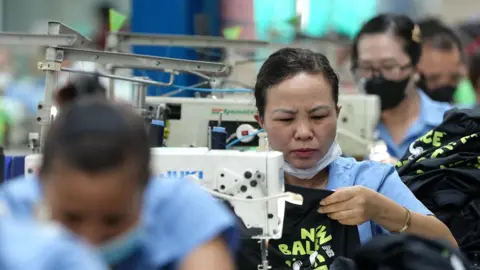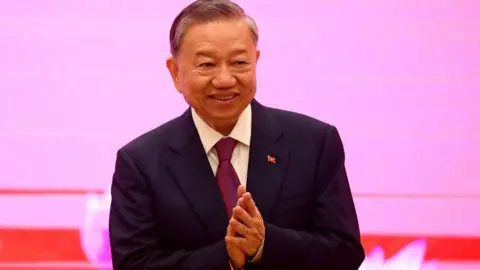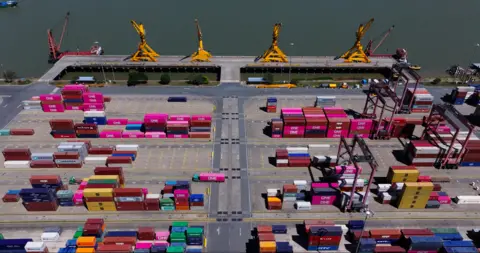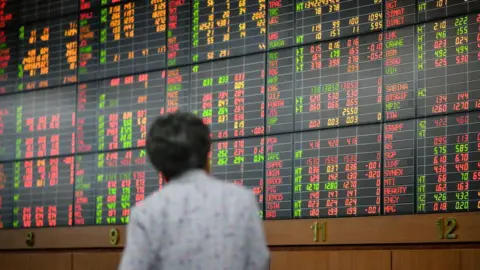Trump's tariffs are a huge blow to Vietnam's economic ambitions
 Getty Images
Getty ImagesUS President Donald Trump's sweeping tariffs targeting most of the world are now in effect – and outside China, no other region has been hit as hard as South East Asia.
Near the top of the list are Vietnam and Cambodia which have been hit by some of the highest tariffs: 46% and 49%. Further down are Thailand (36%), Indonesia (32%) and Malaysia (24%). The Philippines gets a tariff of 17%, and Singapore of 10%.
This is a huge blow for a region highly dependent on exports. Its widely admired economic development over the past three decades has largely been driven by its success in selling its products to the rest of the world, in particular to the US.
Exports to the US contribute around 30% of Vietnam's GDP, and 25% of Cambodia's.
That growth story is now imperilled by the punitive measures being imposed in Washington.
The longer-term impact of these tariffs, assuming they stay in place, will vary, but will certainly pose big challenges to the governments of Vietnam, Thailand and Cambodia in particular.
Vietnam's "bamboo diplomacy", where it attempts to be friends with everyone and balance ties with both China and the US, will now be tested.
Under the leadership of the new Communist Party Secretary-General To Lam, Vietnam has embarked on an ambitious plan to build an upper-income, knowledge-and-tech-based economy by the year 2045. It has been aiming for annual growth rates in excess of 8%.
Exporting more to the US, already its biggest market, was central to that plan.
It was also the main reason why Vietnam agreed to elevate their relationship to that of a Comprehensive Strategic Partnership in 2023.
The Communist Party, which tolerates little dissent and has no formal political opposition, depends on its economic pledges for its legitimacy. Already viewed by many economists as too ambitious, these will now be even harder to meet.
 Getty Images
Getty ImagesThailand depends on US exports less than Vietnam – under 10% of GDP – but the Thai economy is in much worse shape, having underperformed for the past decade. The Thai government is trying to find ways to lift economic growth, most recently attempting but failing to legalise gambling, and these tariffs are another economic blow it cannot afford.
For Cambodia, the tariffs pose perhaps the greatest political threat in the region.
The government of Hun Manet has proved just as authoritarian as that of his father Hun Sen, whom he succeeded two years ago, but it is vulnerable.
Keeping the Hun family's hold on power has required offering rival clans in Cambodia economic privileges like monopolies or land concessions, but this has helped create a glut of property developments, which are no longer selling, and a mass of grievances over land expropriations.
The garment sector, which employs 750,000 people, has been a crucial social safety valve, giving steady incomes to Cambodia's poorest. Thousands of those jobs are now likely to be lost as a result of President Trump's tariffs.
 BBC/ Xiqing Wang
BBC/ Xiqing WangUnlike China, which has hit back with its own levies, the official message from governments in South East Asia is don't panic, don't retaliate, but negotiate.
Vietnam has dispatched deputy prime minister Ho Duc Phoc to Washington to plead his country's case, and has offered to eliminate all tariffs on US imports. Thailand plans to send its finance minister to make a similar appeal, and has offered to reduce its tariffs and buy more American products, like food and aircraft.
Malaysian Prime Minister Anwar Ibrahim is also heading to Washington, though with exports to the US making up only 11% of Malaysia's total, his country is less affected than some of its neighbours.
However, the Trump administration appears to be in no mood to compromise.
Peter Navarro, President Trump's senior counsellor on trade and manufacturing and one of the main thinkers behind the new policy, said in interviews on Monday that Vietnam's offer of zero tariffs was meaningless, because it would not address the deficit in trade where Vietnam sells $15 worth of goods to the US for every $1 it buys.
He accused Vietnam of keeping multiple non-tariff barriers to US imports, and said that one-third of all Vietnamese exports to the US were actually Chinese products, trans-shipped through Vietnam.
The proportion of Vietnamese exports which are being made or trans-shipped there to avoid US tariffs on China is difficult to assess, but detailed trade studies put it at between 7% and 16%, not one-third.
 Getty Images
Getty ImagesLike Vietnam, the government of Cambodia has appealed to the US to postpone the tariffs while it attempts to negotiate.
The local American Chamber of Commerce has called for the 49% tariffs to be dropped, making the point that the Cambodian garment industry, the country's biggest employer, will be badly affected, but that no tariff level, however high, will see clothing and footwear manufacturing return to the US.
Perhaps the most perverse tariff rate is the 44% applied to Myanmar, a country mired in a civil war, which has no capacity to buy more US goods.
US exports make up only a small proportion of Myanmar's GDP, less than 1%.
But as in Cambodia, that sector, mainly garments, is one of the few that provides a steady income to poor families in Myanmar's cities.
In a supreme irony, Trump has until now been a popular figure in this region.
He has been widely admired in Vietnam for his tough, transactional approach to foreign policy, and Cambodia's former strongman Hun Sen, still the main power behind the scenes, has long sought a close personal relationship with the US president, proudly posting selfies with him at their first meeting in 2017.
Only last month Cambodia was praising Trump for shutting down the US media networks Voice of America and Radio Free Europe, which often carried the views of Cambodian dissidents.
Now Cambodia, like so many of its neighbours, finds itself in a long line of supplicants pleading with him to ease their tariff burden.
